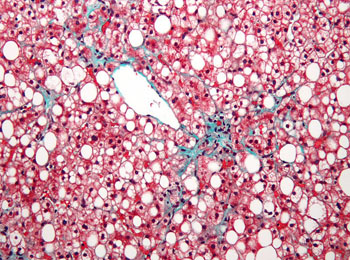Stem Cell-Based Model System to Boost Research on Nonalcoholic Fatty Liver Disease
By LabMedica International staff writers
Posted on 12 Jul 2016
A team of German liver disease researchers created an in vitro model of nonalcoholic fatty liver disease (NAFLD) using induced pluripotent stem cells that had been differentiated into hepatocyte-like cells.Posted on 12 Jul 2016
NAFLD or steatosis is a metabolic disease characterized by the incorporation of fat into hepatocytes. Initially it is a benign state, but it can progress to NASH /steatohepatitis, an inflammatory disease of the liver that can lead to fibrosis, cirrhosis, or even liver cancer. Lack of a suitable in vitro model system has slowed research on NAFLD.

Image: A micrograph of non-alcoholic fatty liver disease (NAFLD). The liver has a prominent macrovesicular steatosis (white/clear round/oval spaces) and mild fibrosis (green). The hepatocytes stain red. Macrovesicular steatosis is lipid accumulation that is so large it distorts the cell\'s nucleus (Photo courtesy of Wikimedia Commons).
This situation has been corrected by investigators at Heinrich-Heine University Duesseldorf (Germany). They reported in the June 16, 2016, online edition of the journal Stem Cells and Development that they had developed an in vitro model for NAFLD based on hepatocyte-like cells (HLCs) differentiated from human pluripotent stem cells. They induced fat storage in these HLCs and detected major expression changes of metabolism-associated genes as well as an overall reduction of liver related microRNAs. MicroRNAs (miRNAs) are a small noncoding family of 19- to 25-nucleotide RNAs that regulate gene expression by targeting mRNAs in a sequence specific manner, inducing translational repression or mRNA degradation, depending on the degree of complementarity between miRNAs and their targets. MicroRNAs have been shown to be involved in the regulation of gene expression during development, cell proliferation, apoptosis, glucose metabolism, stress resistance, and cancer.
The investigators observed up-regulation of the lipid droplet coating protein Perilipin 2 (PLIN2) as well as of numerous genes of the peroxisome proliferator-activated receptor (PPAR) pathway, which constitutes a regulatory hub for metabolic processes. This model recapitulated many metabolic changes that are characteristic for NAFLD. For example, interference with PLIN2 and PPARalpha resulted in major alterations in gene expression, especially affecting lipid, glucose, and purine metabolism.
"Although our hepatocyte-like cells are not fully mature, they are already an excellent model system for the analysis of such a complex disease," said first author Dr. Nina Graffmann, a postdoctoral researcher at Heinrich-Heine University Duesseldorf. "In our system, we can efficiently induce lipid storage in hepatocyte-like cells and manipulate associated proteins or microRNAs by adding various factors into the culture. Thus, our in vitro model offers the opportunity to analyze drugs which might reduce the stored fat in hepatocytes."
Related Links:
Heinrich-Heine University Duesseldorf













